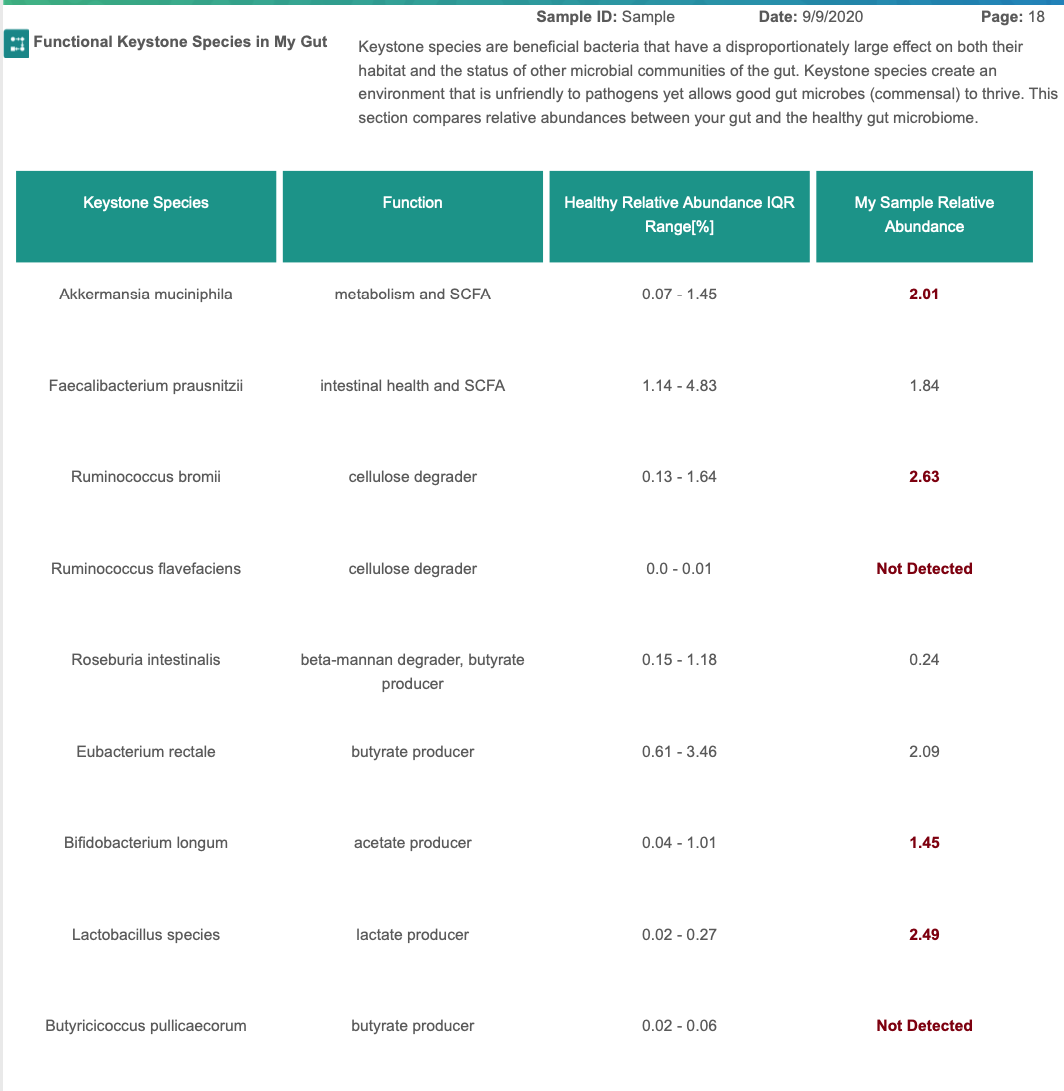New stool analysis technology can give us an accurate view of the microbes in the microbiome – and more importantly, provide a template for personalized diet, lifestyle, and supplement strategies to optimize the results.
The gut microbiome is at the center of metabolic and immune health.
We have co-evolved with the trillions of friendly microbes in the gut.
They help us pull energy from food, train our immune system, protect us from pathogens, metabolize our hormones, synthesize nutrients and even play important roles in our mood and brain health.
So how do we know if the microbiome is in good health or not? And, will such testing give us insights on how to fix it when things are off? Stool sampling has been a controversial testing option as to the usefulness of the readouts for determining the health of the gut microbiome.
Stool sampling has been a controversial testing option as to the usefulness of the readouts for determining the health of the gut microbiome.
We know that the health of the gut microbiome is of prime importance for gastrointestinal health, as well as immunity, brain health, and mood balance.
We also know that a rich, diverse, and stable microbiome is consistent among all healthy guts whether you’re asking about inflammatory bowel disease, autoimmunity, or more.
There are a number of strategies to improve the health of the microbiome, and a high-quality microbiome analysis will give you the means to “check your work” periodically to see if you’re moving the needle towards a better microbiome.
Not all stool tests are equal, however, as technologies used and information gathered can vary.
Key issues with Stool and Microbiome Analysis:

1. Diagnostic Value
2. Technology
3. The diverse and ecological nature of the microbiome person-to-person
1.) Diagnostic Utility
Stool testing is less equipped to identify infection, leaky gut, or small intestinal bowel overgrowth.
What it can be good at is looking at general vulnerabilities to these imbalances and the functional health of the gut.
We can now accurately measure the presence and relative ratios of microbes in the gut. We can measure the diversity of the microbiome, its stability, and how it compares to what’s considered “healthy” in the first place.
Microbiome science has evolved to have identified key groups of bacteria that we know to be present most commonly in healthy guts. We also know the big players when it comes to potential for problems when they’re overgrown.
In addition, our knowledge of the microbiome can give us a sense of strengths and weaknesses in our personal metabolism. We can gain important insights such as how sensitive your system might be to a high protein diet, or how sensitive it may be to high-sulfur foods that are otherwise considered healthy.
Microbiome analysis gives us a holistic “check-in” on:
1.) The overall and functional health of the gut microbiome
2.) Its vulnerability to future problems
3.) A template for improvement when dysfunction is present
When used alongside other tests like organic acid testing (metabolic markers) and conventional testing, you get a much better picture of not only what’s going on with your gut, and potentially why it’s going on, but also serves as an educational template to personalize strategies to improve the overall function of the gut.
It goes beyond whether you have a pathogen, leaky gut, or SIBO, it gets you much closer to why those types of issues may exist in the first place!
While the individual profile will differ from person to person, the richness, diversity, and stability of a microbiome tells us how well our gut is doing whether we’re sick or healthy.
It’s going to show us why someone’s gut may be more “sensitive” than another’s, or, why a trip to the Caribbean may throw off a person’s gut more easily than another’s.
We can also show propensities for certain organisms to be overgrown – and at least can be followed up with more specific medical testing to know if it’s a clinical issue – or to correlate with what you’re experiencing day-to-day.
Microbiome analysis from stool sampling gives us a new tool to “check our work” when implementing healthier diets and functional medicine protocols.
The testing we now use for these purposes is BiomeFX by Microbiome Labs – the same company behind the very popular probiotic Megasporebiotic.
BiomeFx uses a unique core-sampling technique of the stool followed by an advanced technology known as whole-genome sequencing to accurately identify organisms.
Microbiome Labs has also teamed up with CosmosID, a global leader in microbiome data and analysis.
With this data, the BiomeFX functional microbiome analysis can accurately compare your data against an entire database of what is considered a “healthy” microbiome. The more your microbiome differs from the healthy norm – the higher the likelihood of current and future gut problems.
Where the analysis really gets interesting is that you can gain highly personalized insights as to the diet and supplement mix that’s right for you – cutting out much of the guesswork.
Stool testing that utilizes whole genome sequencing is not used for “diagnosis” of specific disease states, it is a measure of the health of your inner ecosystem.
These insights provide a more functional, wellness, and overall health view of the gut that can be a starting point for you and your practitioner to personalize a plan. It also gives us a tool to let us know that what we’re doing is working or if more support may be needed.
So what makes the technology behind BiomeFx different?
2.) Technology:

A test readout is only as good as the test technology used.
Older Technology:
Most stool tests on the market use a technique of sequencing that looks at pieces of genetic material and then uses those splices to connect a greater picture of the whole. The technical name for this technology is 16s Ribosome RNA sequencing – and it’s what most stool testing companies use.
This technique is an older technology, which makes it cheaper to run, so companies tend to like continuing to use it as they can keep stool testing affordable for a wider group of people and keep their own costs of running it low.
You can get a lot of false positives using this technique, where the readout thinks you have a certain set of organisms, but because it was based on pieces of data, the data is based on inferences at best.
And those inferences can change sample-to-sample, or even when running the same stool sample five different times via five different labs using the technology.
There’s a high degree of error, inconsistency, and randomness of readouts among multiple samples from the same person – so much so that the American Gut Project and other research institutes no longer recognize the accuracy of testing using this technology – at least for species level accuracy.
If you remember high school biology, organisms are classified according to a domain, kingdom, phylum, class, order, family, genus, and then species. The old technique can identify on the genus level, and on the species level for some organisms – but whole genome sequencing can more accurately identify single species with much less error.
The older 16s Ribosome RNA sequencing is equivalent to identifying a person out of a crowd of thousands with a picture of their elbow, the back of their head, and their knee. It’s impossible to know the exact organisms that you’re working with.
When dealing with thousands of potential species, this inconsistent technology is problematic when trying to extract useful information from the report.
For instance, you could tell someone’s skin color, hair color, sex, or perhaps some information on ethnicity, but you can have more difficulty really knowing in a group of thousands that you are talking about one specific person.
With this older 16s Ribosome RNA testing technology, it is difficult to know if you’ve identified the organisms accurately – and it requires an amplification process that adds error.
Newest Technology:
BiomeFx by Microbiome Labs uses the latest technology: whole-genome sequencing.
Whole-genome sequencing uses a full picture of an individual to find them amongst the crowd. There’s a lot less “guesswork” as to what organisms are being correctly identified.
With this more exact profile of who’s present or not present, the data can then be cross-checked against huge data pools of what a healthy microbiome looks like in your region.
So instead of the pieces of the picture, you have a photo of the person and can look in the crowd of thousands to identify them. Whole-genome sequencing is more useful and more accurate.
Now that we can more accurately identify organisms – we need to understand those organisms in the context of the environment in which they live.
We need to look holistically at the health of the entire ecosystem of the gut – not just the presence of pathogenic and non-pathogenic strains of microbes. Each of us has a unique microbial fingerprint – while we’ve tried to find specific bugs responsible for different disease states – the data is not consistent.
What’s important is the overall richness, diversity, and stability of the whole system – so that the mere presence of a pathogen is more than counterbalanced by many other microbes.
In fact, in normal levels, many microbes that may become problematic if overgrown may actually provide health benefits to us when they’re present in normal ratios.
So the 10,000-foot view on a family and genus level is much more useful for you and me than focusing on the individual presence or non-presence of specific organisms.
In the end, it’s the overall ecology, and improving that ecology, that matters.
BiomeFx takes this more accurate technology to another level with a more accurate sampling process. The kit uses a high-contact coring brush that is used to take a “core sample” of the stool in various locations and depths to collect DNA through the entire stool contents.
You poke the stool with the coring brush in 10-12 different locations as opposed to scooping out a portion of the stool.

As the stool passes through the digestive system, the inner part of the stool is going to reflect what’s going on earlier in the gut, and the outer part of the stool reflects more of what was added in the later part of the gut.
With the high-contact coring method, you get a lot more DNA in the sample to show what’s present throughout the entire GI system.
More DNA means a more comprehensive and accurate picture of your microbiome. With whole-genome sequencing, the DNA is read more accurately to the sub-species and strain levels with far fewer false positives than the old technology.
The kit does not involve those plastic “hats” that sit on your toilet seat, instead, they’ve made the collection apparatus completely flushable after you’ve finished poking your sample 10-12 times in different locations with the coring brush.
The material on the coring brush is dipped into the preservative material inside a test tube to deliver the fecal material, the cap on the test tube is screwed on tight, and you place the test tube into a sealed sample bag, the bag is placed in a prepaid envelope, and sent out in the mail.
3.) An Ecological View of the Gut Microbiome:

The microbiome works very much like a fingerprint.
Each person has a unique fingerprint to their microbiome that can reflect their diet, their lifestyle, and the local region where they live.
BiomeFx gives you a readout and analysis of your unique microbiome fingerprint. In doing so, we’re not looking at the growth of specific organisms, instead we’re looking at the relative abundance of those organisms.
BiomeFx takes microbial data and cross-references it with a highly comprehensive database that gets smarter and more accurate each day as more data is populated into the system.
There’s a reason that if you go to another country and drink the water and eat the local food, it can take a few weeks or a couple of months for your system to adjust – this is because you need time for your microbial “fingerprint” to adapt to the new region.
In the meantime, many of us have experienced some extra trips to the bathroom during a vacation even though the locals aren’t affected at all by the same food or water.
Because the exact species make-up will differ person to person and region to region, it’s more useful to look at the overarching patterns – a 10,000-foot view of what microbes are present and their relative ratios to one another.
The species make-up will naturally differ person-to-person. Most pathogens are naturally present in the gut – it’s when the relative abundance ratios are off that they can be clinical problems – just identifying the presence of a pathogen tells us little about the functional health of the gut.
A weed can be present but is unable to spread if there’s enough of the right competing plants around it. A weed here or there is normal; weeds only become a problem when they overgrow and take away resources from the keystone plants you want to be there.
If you lose keystone species, you may lose the stability of the ecosystem – and the overall health of the ecosystem will drop – making it much more likely that weeds and invasive species will grow.
The same concept applies to opportunistic and friendly bacteria in the gut.
Instead of looking at the presence or non-presence of specific organisms – it is more useful to look at patterns and ratios of microbe diversity and how closely that composition compares to what’s “healthy” on a regional level.
BiomeFx’s microbiome analysis does that for you, from which you can gather a personalized plan for improving the health of the gut.
 Discover the unique bacterial fingerprint of your microbiome with BiomeFx from Microbiome Labs.
Discover the unique bacterial fingerprint of your microbiome with BiomeFx from Microbiome Labs.
The health of an ecosystem is measured by how many organisms are present, how well they compete with each other, and how well each niche in that ecosystem is served by an organism. Some keystone species have stronger influences on the overall health of the environment than others.
The gut is like a rainforest in this sense – and we now have tools to measure this, and useful data to compare them to.
You can see where your microbiome falls compared to the norm, and better yet, you can get very specific action steps based on the layout of your gut ecosystem.
Introducing the BiomeFx Microbiome Report from Microbiome Labs
.jpg) The thrust of the BiomeFX results is the measures of diversity it provides in the beginning of the report.
The thrust of the BiomeFX results is the measures of diversity it provides in the beginning of the report.
In other words, how healthy is my microbiome?
My Gut Microbiome Index, Alpha Diversity, Beta Diversity, and Resistome:
These markers give you a personalized “report card” for the health of your microbiome.
Each index provides unique clues to the richness and stability of the microbial rainforest in your gut.
It also compares the nature of that rainforest to known patterns that are healthy in those without gut issues.
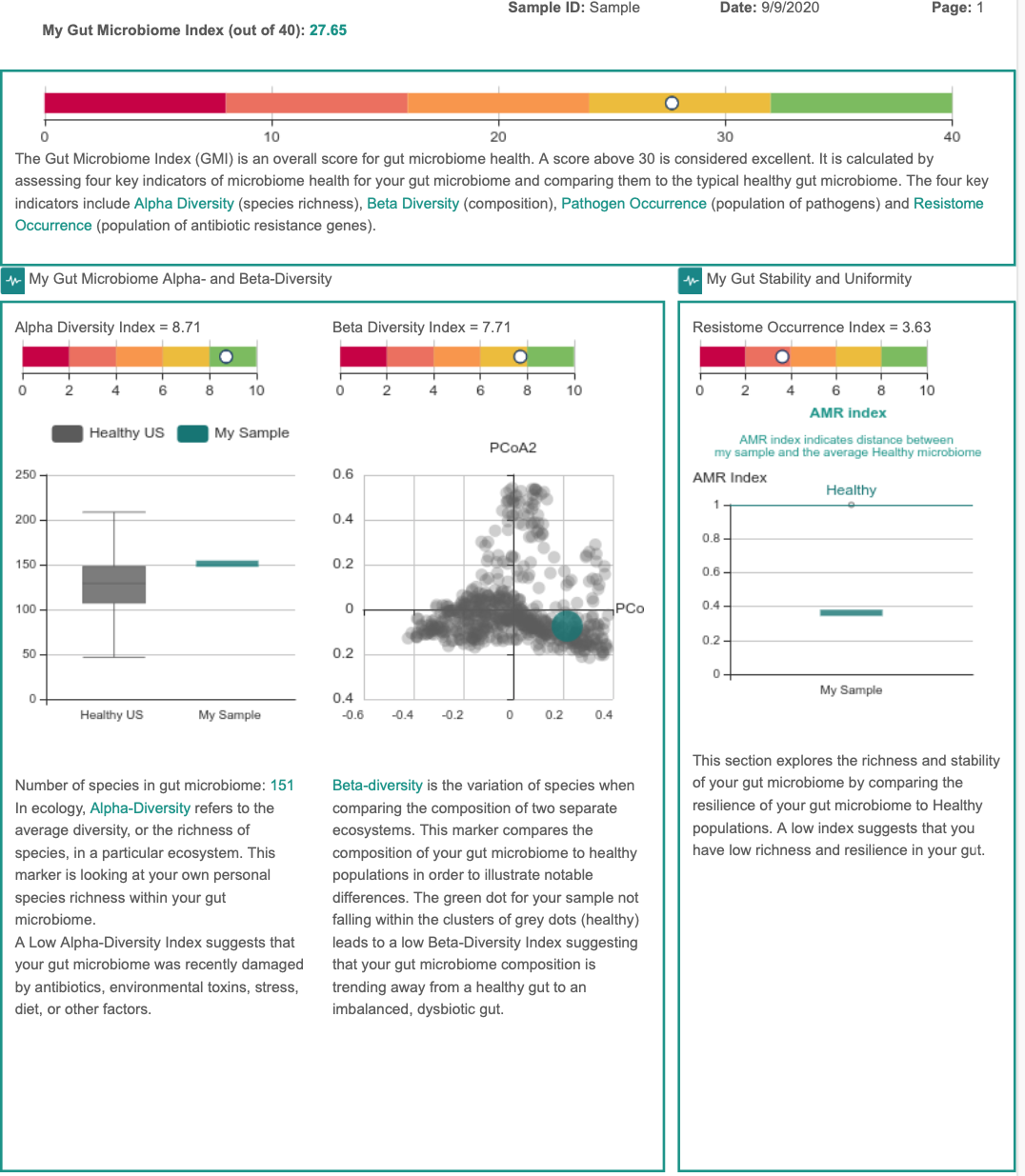
View Full Report PDF (subject to updates)
First, the BiomeFx analysis gives you a global health assessment known as the Gut Microbiome Index.
This number ranges from 0-40 and gives you the best total assessment of how healthy your microbiome is at this given moment. A score of 30 or better is optimal.
This gut microbiome index is based on three sub-measures that you want to compare report-to-report.
These are:
-Alpha diversity – how diverse your microbiome is on average
-Beta diversity – how your microbiome fingerprint compares to what’s considered healthy
-Resistome – how stable your microbiome and resistant it is to “challenges”
The report also includes graphical representations of how your microbial composition compares to their database of healthy microbiomes. It compares your data on the phylum and family levels:
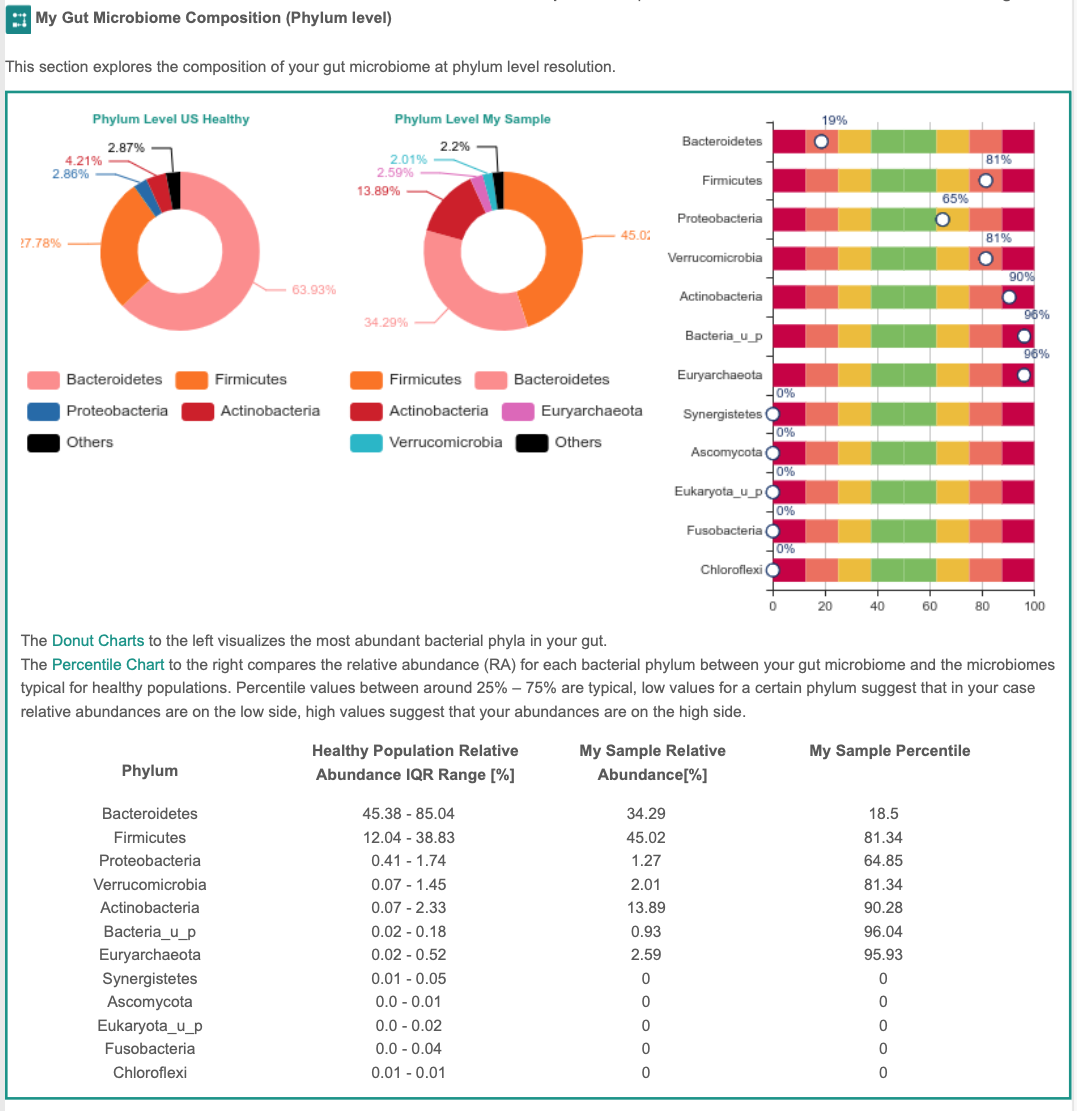
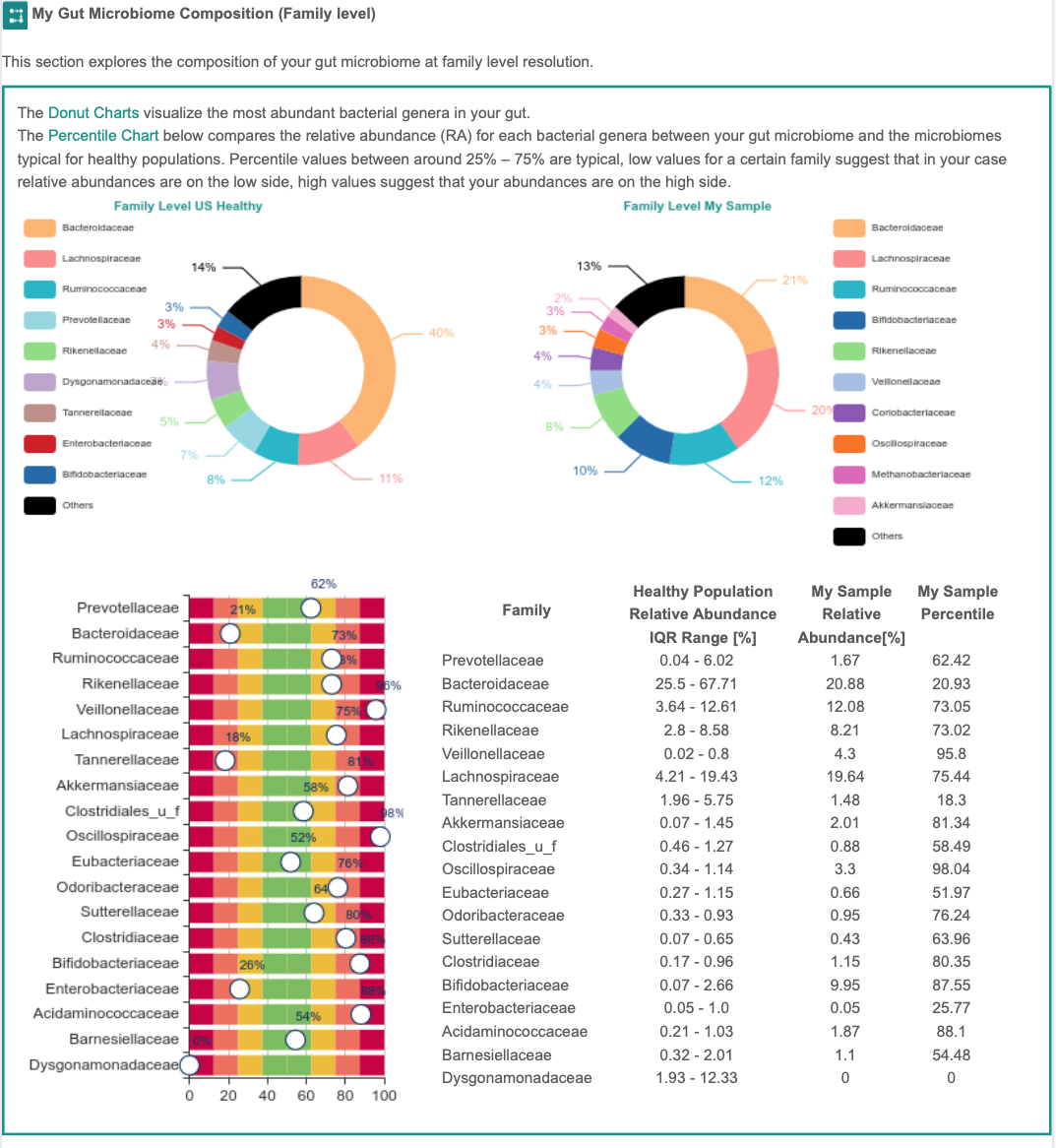
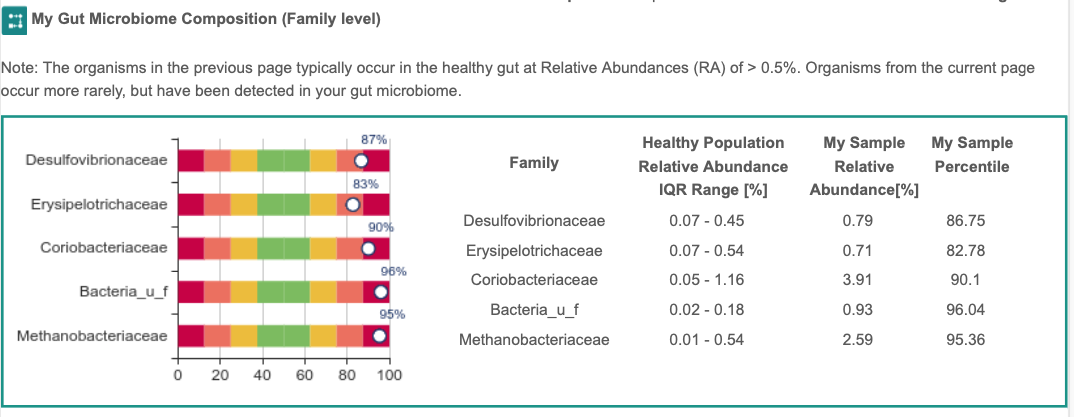
Dysbiosis and Biologically Important Species
Next, the profile gives you ratios that indicate dysbiosis and the health of biologically important species. This looks at the relative ratios of microbial species within your microbiome.
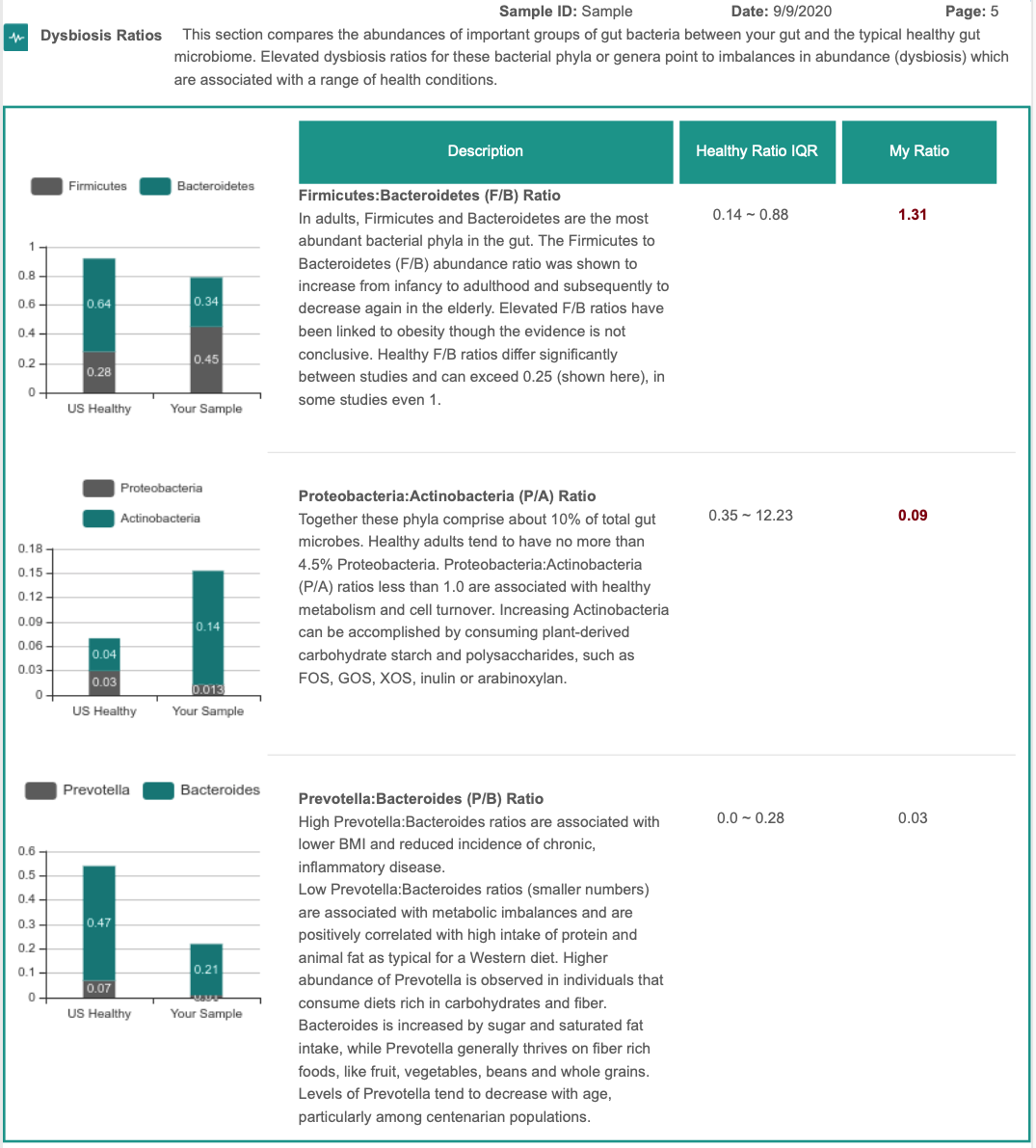
View Full Sample PDF (subject to updates)
These general ratios and highlighted bacteria are considered key players in the overall health of the gut.
They let you know how well your microbiome is able to process metabolites such as estrogens, sulfates, and ammonia – along with other measures.
This part of the report, along with the keystone species report below, is where the rubber meets the road when it comes to strategies to improve the more holistic measures of health earlier in the report.
This again gives you and your practitioner a template for cutting-edge, actionable, personalized strategies for what’s right for your gut.
A high-protein diet is generally healthy – but may not be right for you. Healthy foods like garlic and onions should generally be plentiful in diets – but maybe not so much for you, or maybe they are more needed for another individual.
The BiomeFx report will let you know.
Pathogen Control Index and Pathobiome:
Next, the report lets you know your vulnerability to pathogenic overgrowth, and moreover, what pathogens are more likely to become problematic.
BiomeFx calls this your Pathogen Control Index and Pathobiome.
Pathogen Control Index:
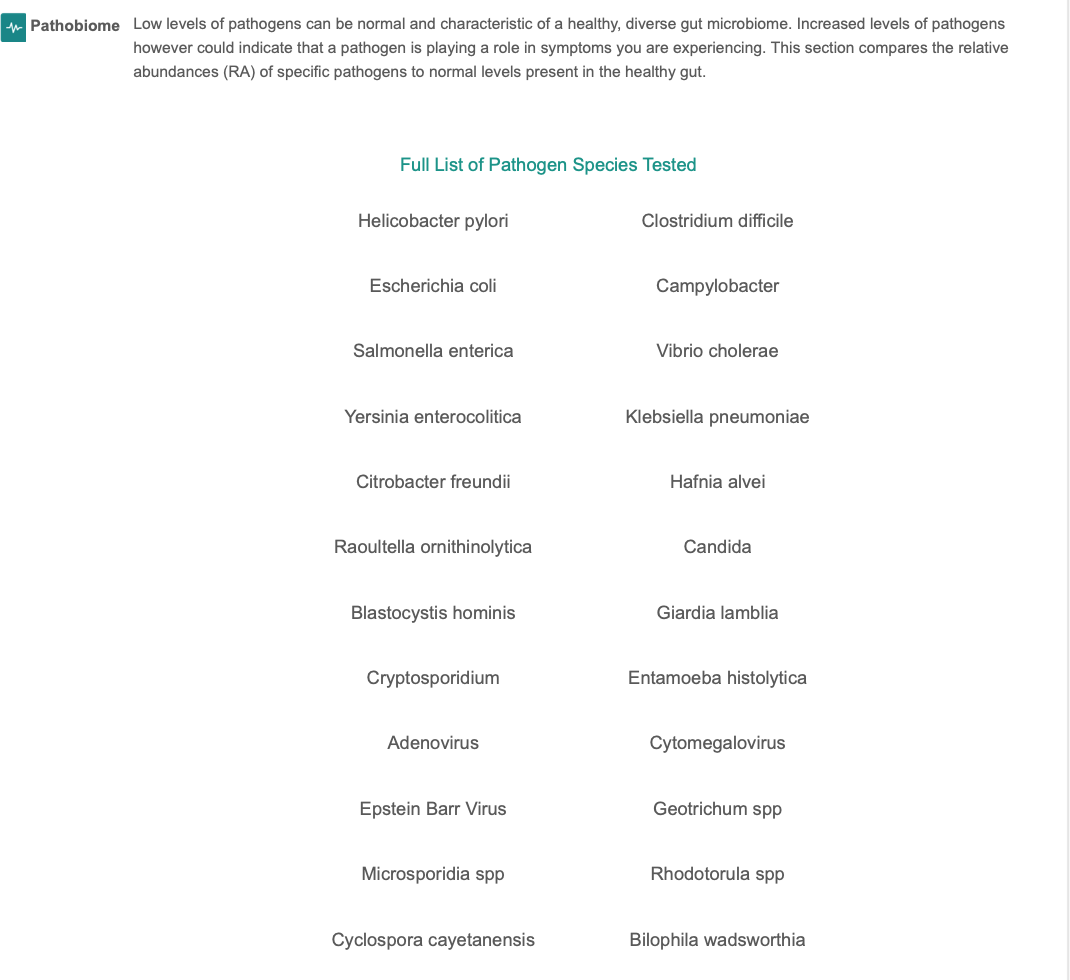 View Full Report PDF (subject to updates)
View Full Report PDF (subject to updates)
The pathogen control index identifies how well your microbiome is suited to control a number of known pathogens. The higher the index, the better able your microbiome is at generally controlling pathogens.
This is because microbes in your gut naturally police themselves by producing natural antibacterial compounds.
The better able your organisms are to stand their ground against competing organisms – the better your gut is going to be at fending off future pathogenic threats.
If some of your pathogens are resistant to this competition – they’re more likely to become future problems.
The Pathobiome is not whether you have pathogens or not, it’s how well your system is at controlling them.
It then gets more into the nitty-gritty of your Pathobiome – an analysis of which specific organisms are more likely to become problematic or overgrown IF overgrowth was to be present.
More importantly, it gives you a template for choosing natural strategies to keep these guys at bay to supplement a medical plan or mitigate the risk of them becoming medical issues in the first place.
Functional Analysis of the Microbiome
This section looks for microbial genes that are known to provide metabolic functions of the body. A higher value means your microbiome has a higher potential for the activity, a low value does not mean the metabolite is low, these numbers tell one the extent that their microbiome can contribute to your levels.
With high or low potential to produce a metabolite, the findings give you a sense of your microbiome’s capacity to produce a certain metabolite and may reflect a baseline indication of vulnerability to excess or deficiency.
Microbiome research is still progressing daily and the report findings are intended as a piece of the puzzle, not an answer sheet.


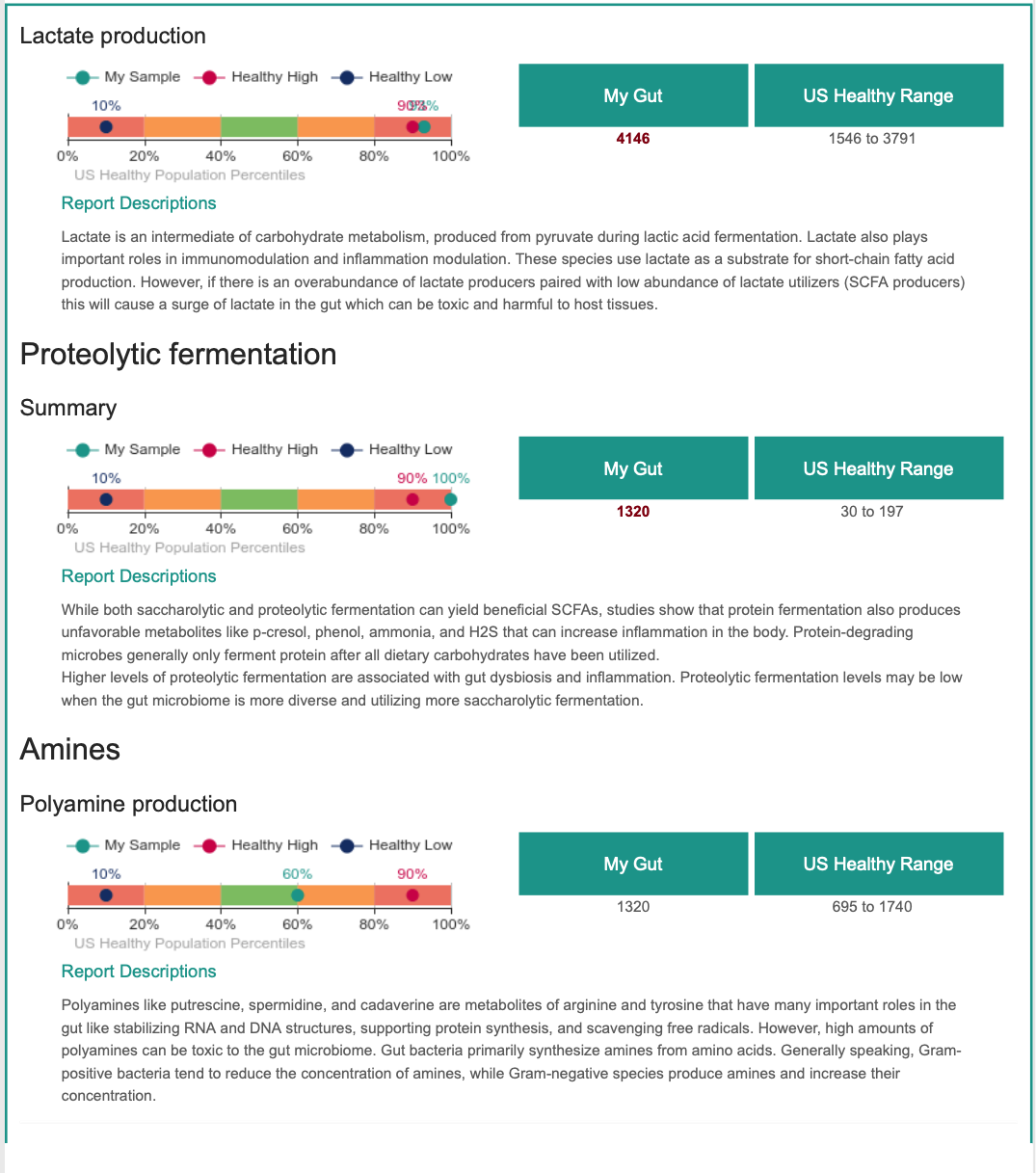

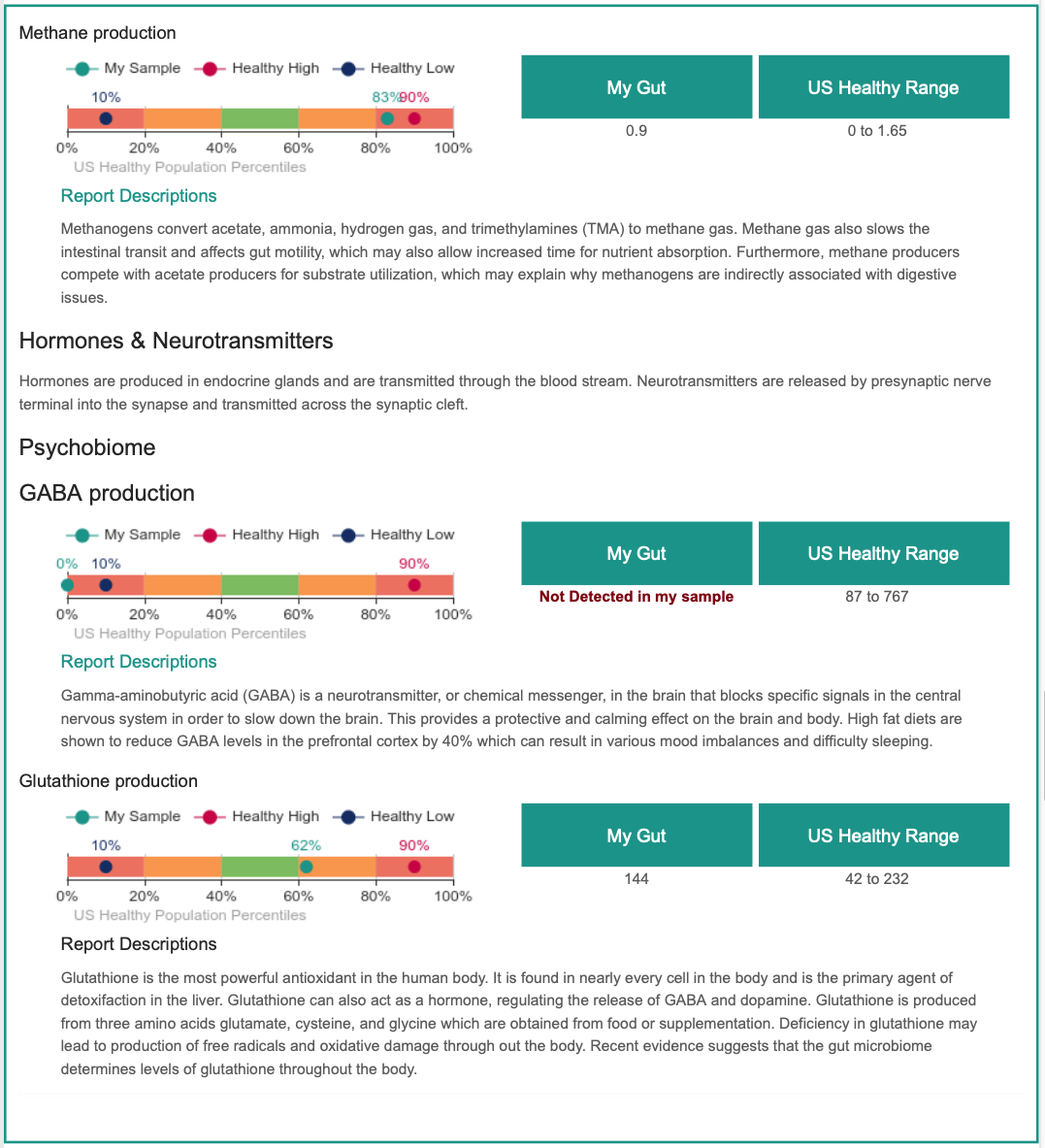


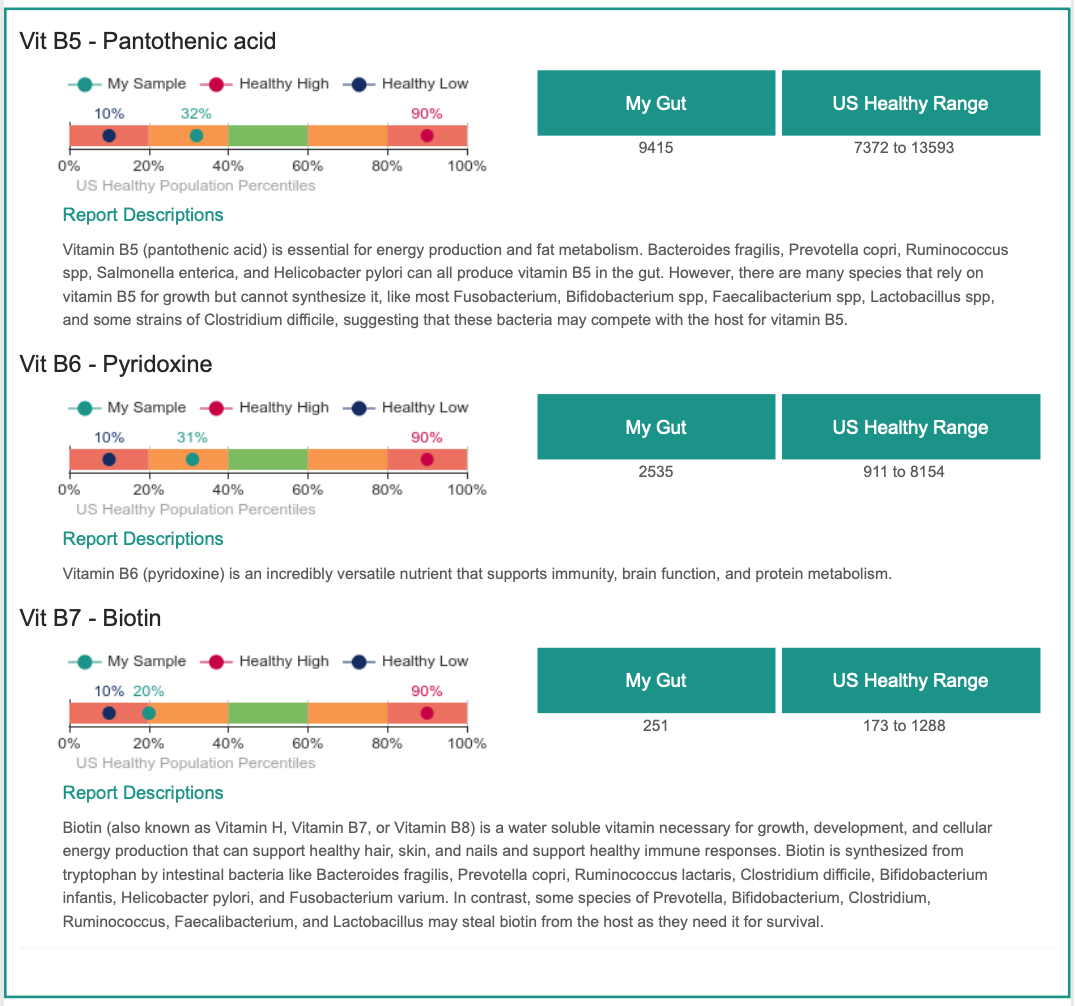

Keystone Species of the Microbiome
Next, the report details the relative abundance of key strains of bacteria.
Microbiome research has evolved to let us know that certain keystone strains anchor the health of the gut microbiome – and these keystone strains need to be in the appropriate abundance for a healthy functioning gut.
Many who take the test will find that they have a low abundance of a number of keystone strains of beneficial bacteria that become a key focus of their gut protocol.
These species play central roles in regulating the gut mucosa, promoting the growth of beneficial bacteria, and maintaining resilience against a leaky gut.
View Full Report PDF (subject to updates)
How to Obtain BiomeFx Testing from Microbiome Labs
BiomeFx is available to you for purchase outside of a health office or with a functional health provider – the report is personalized and self-explanatory to a degree, although, you might need further follow-up to help you read the test and develop a customized game plan.
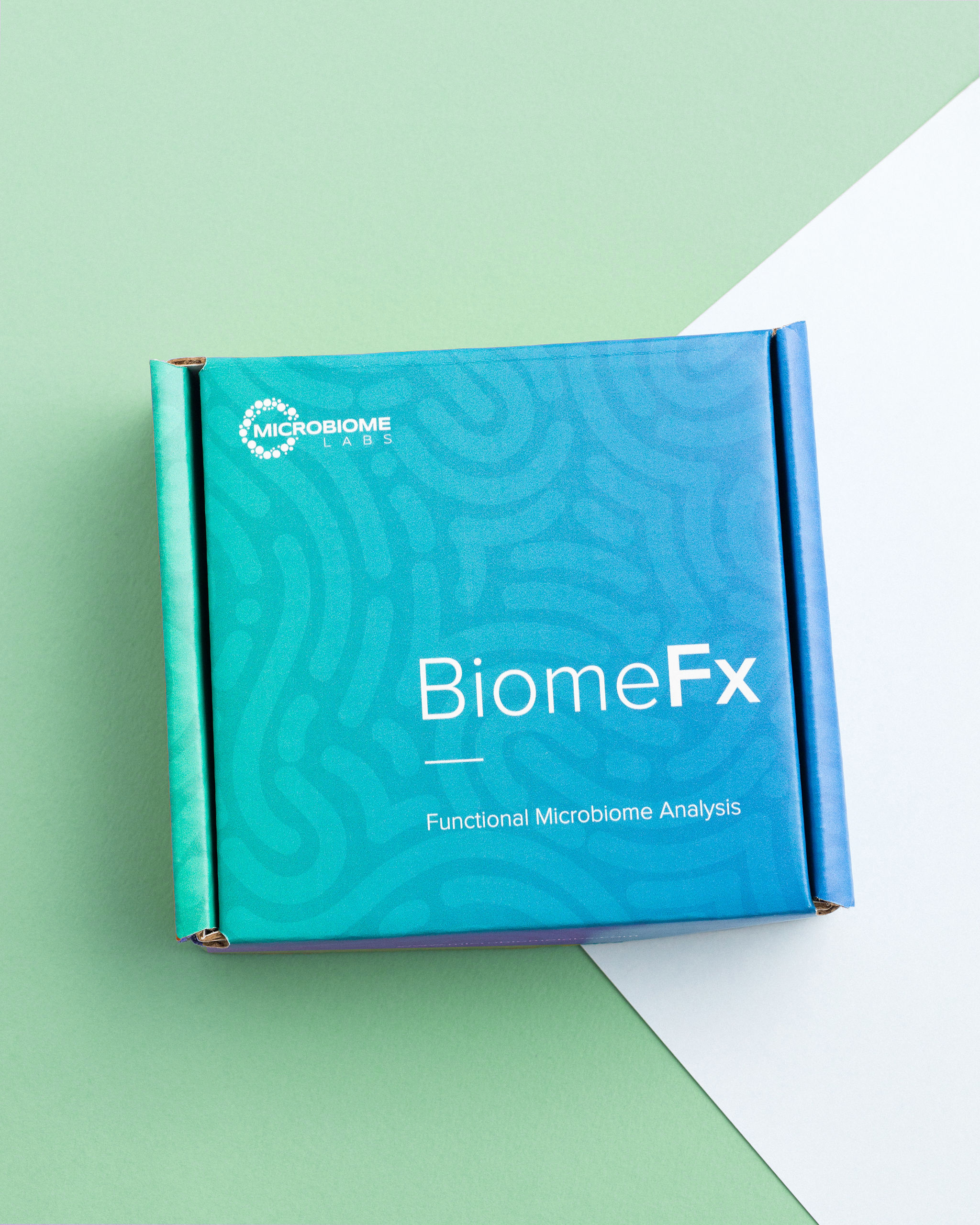
Click here to view test details and register for a kit to be mailed to your home (available in the US only).
Upon purchase, a kit is sent to your home with full instructions. The final sample is collected in a test tube found in your kit, and it is safely packaged and mailed back in a prepaid envelope.
Results are provided in a 2 week period – during which you will want to be continuing your diet, lifestyle, and supplemental strategies.
How Often Should I Test the Gut Microbiome?
Subsequent follow-up testing can be conducted as early as every two months.
Depending on how much support you need, I may suggest follow-ups after three or six months of a gut healing protocol with dietary and supplemental strategies to allow enough time for changes to be implemented.
Changes in the gut microbiome can start happening almost immediately with the composition of your last meal and major shifts can start to be seen in as little as two-three weeks.
“Looking under the hood” and checking in should be done after a minimum of two months have passed to make the most of follow-up testing.
If you know progress still needs to be made, there’s no shame in waiting longer to do a follow-up test – you and a functional health provider can determine the frequency right for you and your goals.
Two months is a good minimum standard for re-testing to get a good sense of how your diet and supplement protocol is working.
You may find that 3-6 months may give you a more reasonable timeframe to troubleshoot a gut protocol and advance your protocol prior to re-testing.
Microbiome has a sample protocol of how their products may be used in a gut restoration model:
Microbiome Labs Total Gut Restoration Protocol.
Developing an Action Plan for the Gut Microbiome
Personalization is the name of the game when it comes to the gut.
- Foremost, you can now equip yourself with the BiomeFx microbiome analysis to help provide a template for you, your doctor, or further research on how to promote certain ratios or groups of bacteria so that you may personalize your approach.
- I also have educational resources that take some broader looks at approaches to gut healing and microbiome restoration that further help you and your health professional personalize a strategy.
- 7 Core Strategies to Health the Gut Lining and Manage Leaky Gut Naturally
- Dr. Rinehart’s Probiotic Blueprint – Avoiding Pitfalls with a Stepwise Approach
- Probiotics and C Diff – What Probiotics Should be Taken With or After Treatment with Antibiotics?
- Everything You Need to Know About Bacillus spore probiotics and Megasporebiotic (including the leaky gut clinical trial that put the formula on the map)
- Seven Best Lifestyle Strategies to Support a Healthy Microbiome
- Probiotics and Gut Health
BiomeFx can also be used for annual or semi-annual “check-ins” on the overall health of your gut, or perhaps to see how the microbiome is faring after a round of antibiotics or other therapy.
Remember, the one thing that is consistent among healthy guts versus dysfunctional guts is the overall richness, diversity, and stability of the microbiome!
You no longer have to wait for a problem to develop before taking action – you can be proactive and even make it a healthy game for yourself to improve your microbiome year over year.
Now, we have cutting-edge technology – with cutting-edge markers that can be the blueprint you and your practitioner need to develop a highly personalized plan in the context of your other health markers.



